Nitinol is an alloy that will remember a shape you select, and
whenever you heat it to a certain temperature called the
transistion temperature,
it will automatically go back to the remembered shape.
Below are things I've made using nitinol wire along with some
tips I've learned along the way.
Simple experiment - the letter "R" for Rimstar.org
A simple first experiment was to bend nitinol wire around some nails
into the shape of a letter R. I then heated it using a candle flame
to above 500C (950F) while still held in the shape of an R. I next
quickly dipped it cool water. After that the shape is remembered by
the wire.
Bent in the shape of an "R".
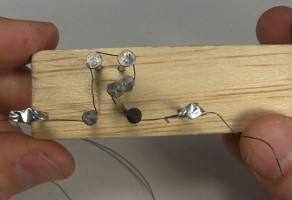 |
|
Heating above 500C (950F).
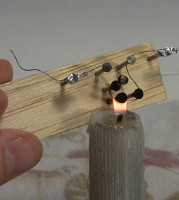 |
|
Quickly cooling in water.
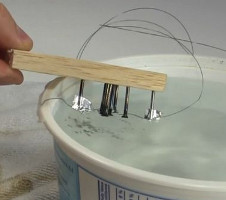 |
|
I next straightened out the wire and then quickly put it in the
candle flame again in order to get it to the transistion temperature.
It went back to the remembered shape of the letter R.
Straightening the wire.
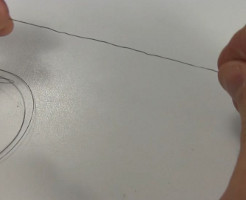 |
|
Restoring the shape.
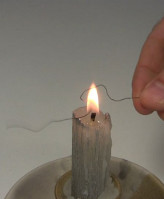 |
|
The shape restored.
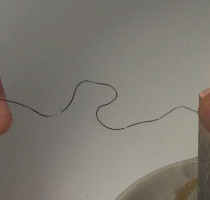 |
|
Measuring the force of a nitinol spring and using electricity to heat it
I also made a spring by winding some nitinol wire around a thick,
rigid clothes hanger wire.
Making a spring out of nitinol wire.
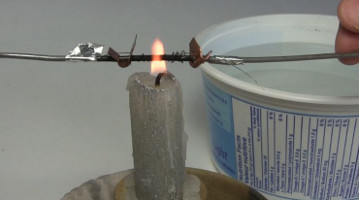 |
|
I wanted to test how much force it could produce when heated
back to its remembered shape. To heat it to its transition
temperature I ran electric current through it with the setup
shown below. The nitinol spring was hung, stretched out, from
a spring balance and the current was measured on a meter.
A potentimeter was connected in series with the circuit to
help limit the current.
Setup for testing the force.
 |
|
As the current was turned up and reached 0.7 to 0.8 amps, the
nitinol wire began to return to its remembered spring shape.
In doing so, it pulled down on the spring balance as much as
it could. The balance showed 27 grams. 27 grams x 0.0098 Newtons/gram
gives a force of 0.26 Newtons.
Measuring the equivalent mass.
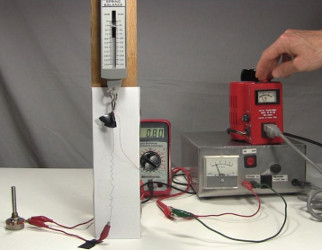 |
|
The equivalent mass - 28 grams.
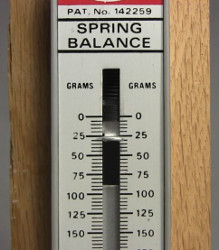 |
|
Nitinol wire/shape memory alloy inchworm
As a fun project I made an
inchworm using a nitinol wire coil to make it walk across a table.
Tips for working with nitinol wire
Here are some things I learned from working with the nitinol wire.
Accidentally increasing the transition temperature
I purchased the wire that I demonstrate above by shaping into an R
and that I shape into a spring below from
Kellogg's Research Labs. It is 0.01" thick. According to their forum, to
set the wire's shape into it's memory you heat it to 500C (950F).
Also, according the the specs for the one I bought, the transistion
temperature at which it restores itself back to its remembered
shape is 70C (160F). But I couldn't get it to go back to its remembered
shape even by putting it in hot water up to 100C (212F). Instead I
had to put it in a much hotter candle flame or run electrical current
through it, producing a higher temperature.
My guess is that at some point I had unknowingly raised the transistion
temperature. Again, according to Kellogg's forum, heating this wire
to 350C (660F) will raise the transistion temperature. My guess is
I'd done that by leaving it in the candle flame sometimes for too
short a time when trying to set the shape. It's also possible I'd
sufficiently heated part of the wire to set the shape but since I
hadn't cut that part from the rest of my wire, the section of wire
next to it got heated to a lower temperature around 350C (660F),
raising the transistion temperature for that section. When I later
went to use that section, it had a higher than expected transistion
temperature.
So be careful of the temperatures you expose your wire to.
Accidentally reprogramming it
Since I didn't know the new transistion temperature for my wire,
I sometimes used a candle flame to get it to go back to its programmed
shape. If I left it too long in the flame then its temperature
sometimes went as high at the required 500C (950F) to set a new shape.
The remembered shape changed to whatever shape it happened to be
in at the time.
So again, good temperature control helps.
For my spring experiments, at least by using electrical current to
get it to go back to its programmed shape, and since I had control
of the current using my power supply and potentiometer, I had some
control of the temperature that way.
In the following video I start with the demonstration of making the
letter R and then follow that with making the spring and measuring
the force as the spring restores its shape using electric current
to produce the heat.












